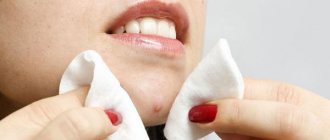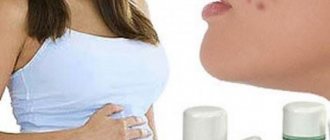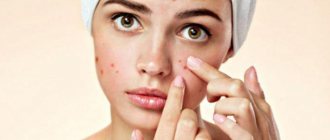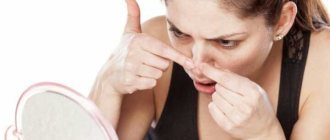Staphylococcus: acne. One of the causes of acne is Staphylococcus aureus. This microorganism is a natural inhabitant of human skin. But under the influence of certain factors it becomes pathogenic, which leads to the formation of acne.
Staphylococcus aureus is a natural inhabitant of human skin.
Types of staphylococcus
Staphylococcus aureus is considered one of the most common and dangerous. It is named so because under a microscope its clusters resemble golden yellow grapes. But there are other varieties of these gram-positive bacteria:
- Epidermal - found on human mucous membranes, is opportunistic.
- Saprophytic - usually infects the genitourinary system and provokes urethritis, cystitis, etc.
- Hemolytic – when released into the blood, it causes sepsis, endocarditis, and damage to the urethra.
Doctors called the form of Staphylococcus aureus, which cannot be treated with traditional antibiotics, methicillin-resistant. This is the most dangerous type of bacteria, resistant to broad-spectrum drugs.
Staphylococcal skin infection in children and newborns
After infection, the child develops:
- at an early stage, vomiting, bowel movements and fever;
- later there are purulent formations throughout the body.
This serious infection can provoke the development of purulent formations, infection of internal organs, infection of the mucous membranes, and the development of sepsis.
Sometimes recognizing the signs of staphylococcus is extremely difficult. Usually they are similar to the development of diathesis, ARVI, dysbacteriosis. To determine the pathology, it is necessary to undergo a laboratory examination, after which the doctor will be able to select adequate treatment methods.
Treatment is not aimed at eliminating symptoms, it must neutralize the infection that caused them.
Main symptom
The main symptom to suspect staphylococcus is acne. Moreover, they can take a variety of forms:
- fluid-filled blisters;
- large red spots (erysipelas);
- boils and carbuncles;
- phlegmons, pustules, abscesses, etc.
It can be very difficult for a non-specialist, and sometimes even an experienced doctor, to recognize staphylococcus at first glance at the skin. However, its characteristic manifestations still exist.
Most often the disease develops as follows:
- first, a red dense tubercle forms, painful when touched;
- it has a cone-shaped shape, at the top of which a white rod gradually forms;
- after ripening, whitish-yellow or green pus comes out of it;
- the skin is affected to a great depth, which causes quite severe pain;
- Intense redness and swelling develop around the pimple.
The most unpleasant thing is that closely spaced acne can merge with each other, forming entire purulent conglomerates. After them, scars often remain, especially if you squeeze out immature pimples with your hands.
Treatment
How to treat a staph infection?
First of all, it must be confirmed by special research.
The detection of staphylococcus does not yet indicate infection; they look, first of all, at the number of these bacteria. And only if this value is exceeded, then special measures are prescribed.
What to do if a large subcutaneous pimple has appeared on your forehead and is swollen around? Find out here.
For staphylococcus, especially for Staphylococcus aureus, only a complex of therapeutic measures is effective:
- fight against bacteria that cause the disease;
- strengthening the immune system.
Treatment is usually carried out with the following groups of medications:
- antibacterial drugs of systemic action - are prescribed for an extensive inflammatory process, when there are many ulcers and they are not localized in one area, for example, the chin, but affect several parts of the body. The selection of antibiotics is purely individual. Drugs are selected after determining the sensitivity of the bacteria to them;
Photo: pharmaceutical acne products
- if the rash is localized to one area of the body (on the face, neck, chest, etc.), then topical antibiotics are used. These are ointments and creams Baneocin, Bactroban, Altargo, etc.;
- staphylococcal bacteriophage is a drug based on viral particles that selectively act on different bacteria, staphylococcal, respectively, on different types of these particular microorganisms. Viruses penetrate the bacteria, causing its destruction. Outside the bacteria, they themselves die, without bringing any harm to humans;
- staphylococcal toxoid is a drug that increases the body's resistance to toxic substances produced by bacteria. It is used when the situation is complicated by extensive infection and contamination;
- immunostimulating drugs - they complement drug therapy, strengthening the human immune system, since the proliferation of staphylococci occurs against the background of its decline.
Treatment of staphylococcal infection is a serious undertaking that requires an individual approach, so it should be entrusted to a specialist.
Features of the disease
The most pathogenic Staphylococcus aureus has its own characteristics in different groups of people, which are important to know about. Although in general the treatment regimen looks approximately the same, doctors must take into account the points listed below.
In adults
Most often, staphylococcus begins to manifest itself when the immune system is weakened or exacerbation of existing chronic diseases. Women typically experience an increase in acne due to staphylococcus before menstruation. During this period, the face can literally become covered with them, and from days 5-7 of the cycle the number of rashes decreases.
Provoking factors that can act as a trigger and cause the appearance of staphylococcal acne on the skin are also:
- severe hypothermia, colds, ARVI;
- skin trauma, including during shaving;
- autoimmune and oncological diseases, HIV;
- severe hormonal imbalance;
- increased sweating and oily skin;
- abuse or use of someone else's decorative cosmetics;
- failure to comply with basic rules of personal hygiene.
Most often, acne caused by staphylococcus appears on the face. But often the hairy part of the chest, the area around the nipples, armpits, back, and delicate intimate area are affected.
In infants
For them, Staphylococcus aureus is especially dangerous, since newborns do not yet have a strong immune system. They may not have the characteristic small purulent staphylococcal acne, but one of its other forms will appear:
- Richter's disease. The infection affects large areas of the epidermis with its subsequent detachment. Moreover, this form of the disease is caused by a certain type of toxin - exfoliatin, which the baby is not yet able to cope with on his own.
- Pemphigus of newborns. Externally it has some similarities with chickenpox. It is also characterized by the formation of many fluid-filled bubbles. But when they burst, inflamed purulent wounds form in their place. With this form, the risk of sepsis is very high.
Moreover, a baby can become infected with the bacteria in the womb, but more often this happens during childbirth due to the negligence of staff or failure to maintain sterility in a medical institution and especially in the delivery room.
In men
Sycosis – this type of disease most often occurs in men. It has a clearly defined localization - around the mouth, on the chin and in the cheek area - exactly where stubble is usually shaved. Sometimes the infection spreads to the scalp.
Purulent inflammation affects the hair follicles. This can lead to their death and the development of alopecia. Unfortunately, in this case one begins to suspect the presence of staphylococcus quite late, when the disease is already rapidly progressing. At this stage, it is difficult to treat and often relapses.
Reasons for pathogen activity
The endocrine and nervous systems are responsible for the functioning of the sebaceous and sweat glands and the acidity of the skin. When the pH of secretory secretions is at the level of 3.5-6.7, conditions are created that are detrimental to the growth and reproduction of pathogenic bacteria, but if this indicator shifts to an alkaline environment, conditions become favorable for pathogenic flora. Such changes occur due to disruption of the endocrine system and disruption of hormonal balance. Also, a decisive role in the development of infection is played by disruption of the skin due to mechanical or chemical injuries (scratching, abrasions, cuts, burns, insect bites).
Causes of acne on the face
When staphylococcus settles on the skin, acne occurs due to both external and internal reasons:
- physical and chemical irritants (shaving, friction against clothing, etc.);
- skin contamination;
- unhealthy diet, especially monotonous, exhausting diets and lack of vitamins;
- any infectious, chronic diseases, exposure to stress have a depressing effect on the immune system;
- frequent ARVI;
- increased sweating (hyperhidrosis);
- overheating, leading to increased secretion of the sebaceous glands;
- diseases of the endocrine system, especially diabetes.
This is not a complete list of reasons that weaken the antibacterial and protective function of the skin.
What is the danger
Opportunistic forms of Staphylococcus aureus can be present on the human body and mucous membranes almost constantly. But a strong immune system prevents them from actively reproducing and causing significant harm to the body. Bacteria cause toxins, but the body eliminates them naturally.
As soon as the immune system weakens for any reason, colonies of bacteria begin to grow rapidly, sometimes affecting quite large areas. If left untreated, they can cause the following serious problems:
- Food poisoning - when a large number of bacteria enter the intestines.
- Bacterial pneumonia, if the mucous membranes of the mouth, larynx and bronchi are affected.
- Bronchitis is when bacteria nest in the nasopharynx or oral cavity.
- Endocarditis is inflammation of the heart sac when staphylococcus enters the blood.
- Meningitis is an inflammation of the mucous membranes of the brain and also occurs from infected blood.
- Osteomyelitis is a purulent-necrotic process in cartilage and bone tissue.
But the worst thing is if staphylococcus provokes sepsis - a general blood infection. In this case, in the absence of qualified medical care, the patient dies literally within a few days.
Is a staph infection on the skin contagious?
This type of microorganism is always present on human skin. In case of any violation of the integrity of the skin, it penetrates into the blood and becomes the cause of the development of inflammatory processes.
You can become infected:
- using non-sterile medical instruments;
- eating dirty, unprocessed food;
- by airborne droplets;
- by household means in case of non-compliance with personal hygiene rules;
- sexually.
A weakened immune system is the main cause of infection.
What to do
If you suspect that acne and other skin problems on the face are caused by staphylococcus, go to the doctor. Do not self-medicate under any circumstances, and even more so, do not take antibiotics without a prescription. If you choose the wrong drug, you will only create an even more favorable environment for the pathogenic bacteria and weaken the immune system.
We take tests
After the initial examination, the doctor will definitely send you to a clinical laboratory for a bacterial culture. A sterile stick is used to take a scraping from the skin or mucous membrane and place it in a sterile environment. This analysis takes several days, during which only external measures can be taken to prevent the spread of the disease and severe deterioration of the skin condition.
Please note that the sample is tested not only for the presence and type of staphylococcus. The laboratory will also determine which group of antibiotics he reacts to most positively. And only after this the doctor will select a medicinal drug individually for you. Usually this is a combination of products for internal and external use, which I will deliberately not list.
Remove acne
Until the immune system is strengthened and the colony of bacteria is significantly reduced, it will not be possible to completely remove rashes caused by staphylococcus. But temporary measures can be taken. Alas, most effective salon treatments for acne and acne are contraindicated in this case. As well as the usual folk remedies: peelings and many masks. All this will contribute to the spread of infection to new areas of the skin.
| Way | Description |
| Pimples can be burned | For this, essential oils, alcohol tinctures (calendula, St. John's wort, propolis) or ordinary brilliant green are used. |
| Clay applications | They can be done very carefully, only in places where acne accumulates. Cosmetic clay is an excellent adsorbent with powerful anti-inflammatory and antibacterial properties. |
| Zinc ointment | Has an excellent drying effect. It promotes rapid healing of wounds remaining after the pus is released. |
| "Bepanten" and other drugs with panthenol | Relieves swelling, redness and inflammation, stimulates tissue regeneration. |
| Cosmetics with triclosan | It also helps to quickly get rid of pathogenic microflora. But keep in mind that it cannot be used for a long time. |
All this is used only in parallel with medications prescribed by a doctor. Otherwise, you will only get a temporary effect, and not always.
We are introducing general strengthening measures
To strengthen the body's own defense, it is simultaneously recommended to take immunomodulators and complex multivitamin preparations. At the same time, you must adhere to the following rules:
- completely eliminate alcohol and, if possible, stop smoking;
- limit exposure to ultraviolet radiation to the affected areas of the skin as much as possible;
- do not visit the sauna, swimming pool, solarium during active treatment;
- do not swim in open water or too hot water;
- do not get too cold and try not to sweat too much;
- remove spicy, fatty and fried foods, coffee and chocolate from the diet;
- eat fresh vegetables and fruits every day;
- drink at least 2 liters of pure still water per day.
To avoid infecting your loved ones, use a separate bed, towel and other hygiene items. After washing, it is advisable to iron your child’s clothes with a very hot iron. This reduces the likelihood of re-infection.
What do pimples look like when infected?
When infection penetrates, pimples appear on the face. They differ from other rashes in their characteristic features.
A dense red bump can be noted on the surface of the skin. It rises above the skin. The shape of the formation is cone-shaped. The top of the pimple is white due to purulent contents. In some cases, a greenish tint is noted.
One of the types of rash
Characteristic signs of a rash caused by staphylococcus are identified.
- The pimple is deeply located.
- In some cases, purulent formation is not noticeable. The pimple looks like a subcutaneous ball or nodule.
- The person feels pain, which intensifies if pressure is applied to the formation.
- Areas of skin become inflamed and hyperemic.
- When several follicles are infected, the formations may merge. In the affected area, large spherical pimples appear.
The general condition of the body may worsen. In some cases, the body temperature rises and the digestive process is disrupted. It is forbidden to remove acne on your own. In this case, a person needs to see a doctor who will prescribe comprehensive treatment.
Summing up
According to reviews from some of my clients who tried to independently treat acne from staphylococcus, often even the usually effective broad-spectrum antibiotics, for example, Amoxiclav, do not give the expected result. Meanwhile, the bacteria mutate and become even stronger, provoking a new batch of rashes. That is why it is so important to get rid of them only under the supervision of a specialist.
If the antibiotic is chosen correctly and the patient follows all medical recommendations, significant improvements in skin condition become noticeable within a month. But it clears completely in 8-10 weeks. You may have had faster results. I would be grateful if you share the methods by which you managed to achieve them in the comments.
Ways to prevent diseases
Preventive measures and a number of precautions will help reduce the risk of developing staphylococcal infections:
- strengthen the immune system (diet and regular exercise),
- personal hygiene (wash hands thoroughly), personal care products and personal wardrobe (do not use other people’s toothbrushes, clothes, sports equipment),
- treat skin lesions, use sterile bandages and plasters for bandaging, the bandage will prevent the spread of microorganisms beyond the wound, will prevent the entry of new infections,
- wash clothes, children's toys, bedding in hot water,
- heat treatment of products and compliance with sanitary and hygienic standards during the cooking process.
Why does the rash appear?
Staphylococcus itself, penetrating the body, does not pose a danger. At a certain point, the bacteria become active. There are several factors that contribute to the awakening of microorganisms:
- decreased immunity of the skin and general defense of the body;
- injury to the skin surface;
- autoimmune diseases;
- malignant tumors;
- endocrine disorders;
- chronic infections;
- the influence of increased or decreased ambient temperatures;
- bad ecology.
The occurrence of a staphylococcal rash on the face is influenced by a person’s age. Children, especially infants and young children, are most often affected by the disease. Their immune defenses of the skin have not yet fully formed. Therefore, it is often possible to see a rash on the face and scalp in children.
Violations are observed with increased sweating. In this case, the bactericidal properties of the skin change. An environment favorable for microorganisms is formed.
Also, inflammation and acne may appear if cosmetic care products are of poor quality.










